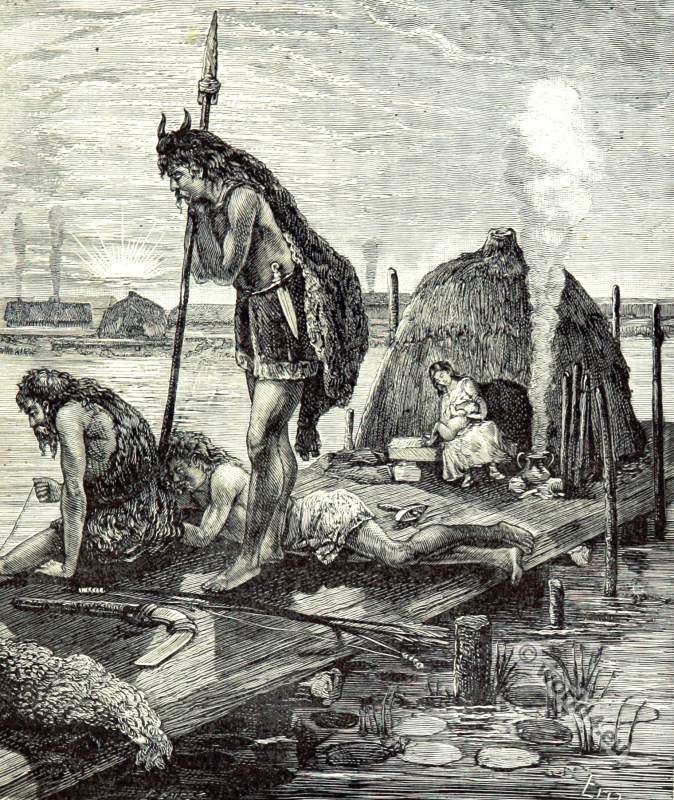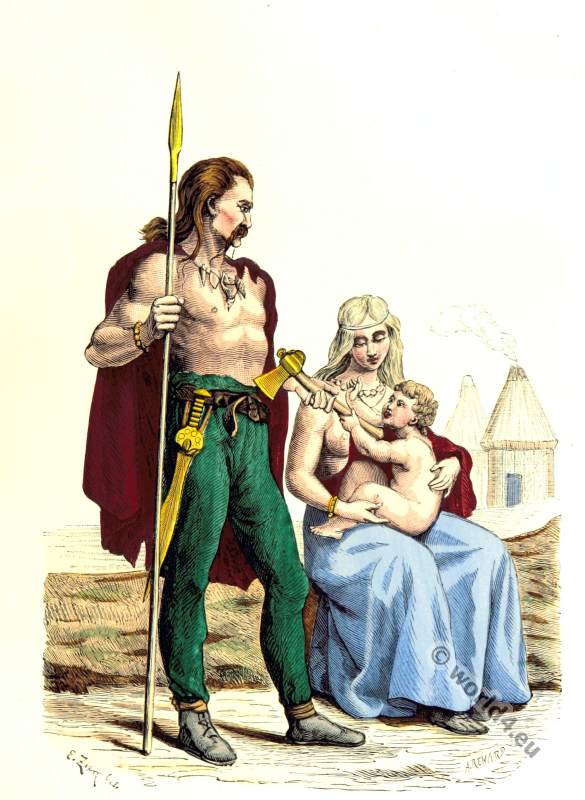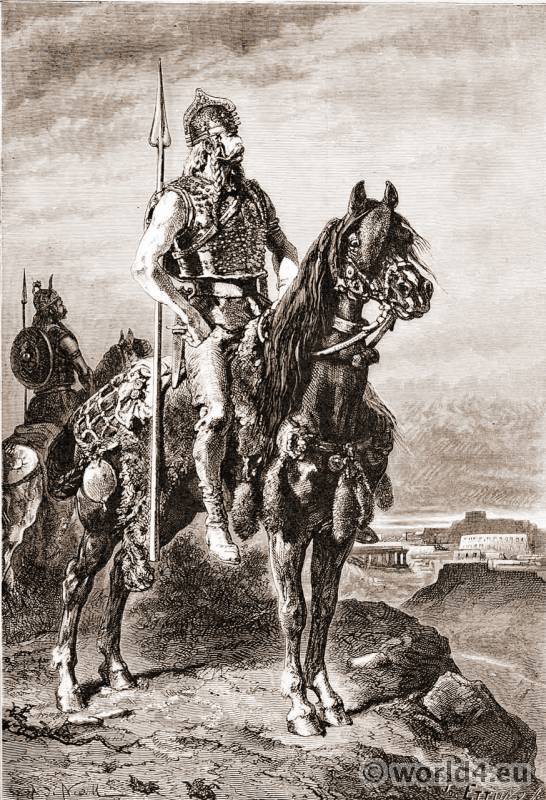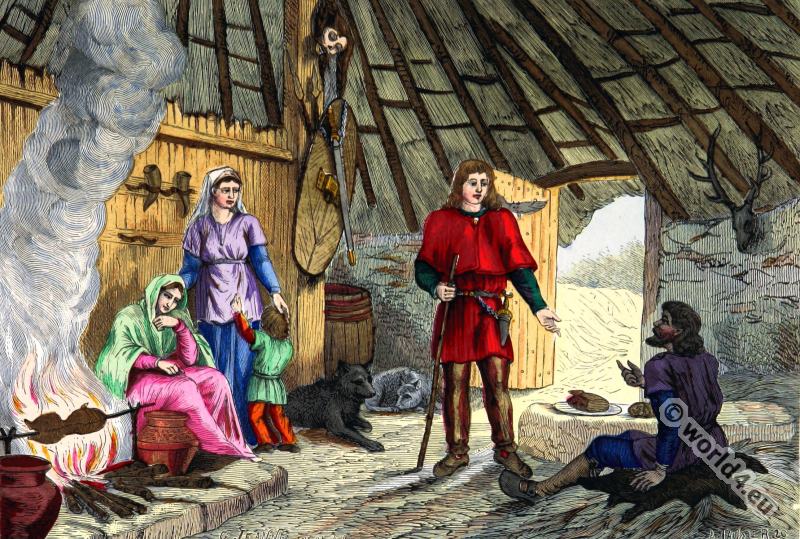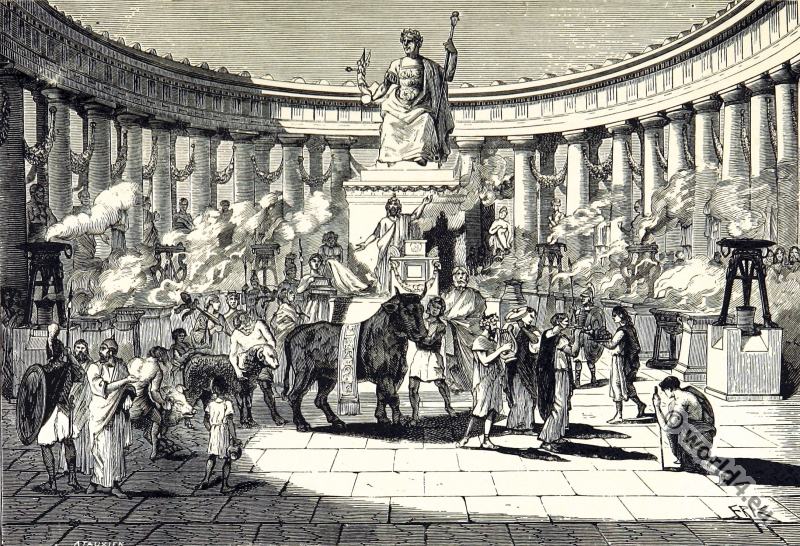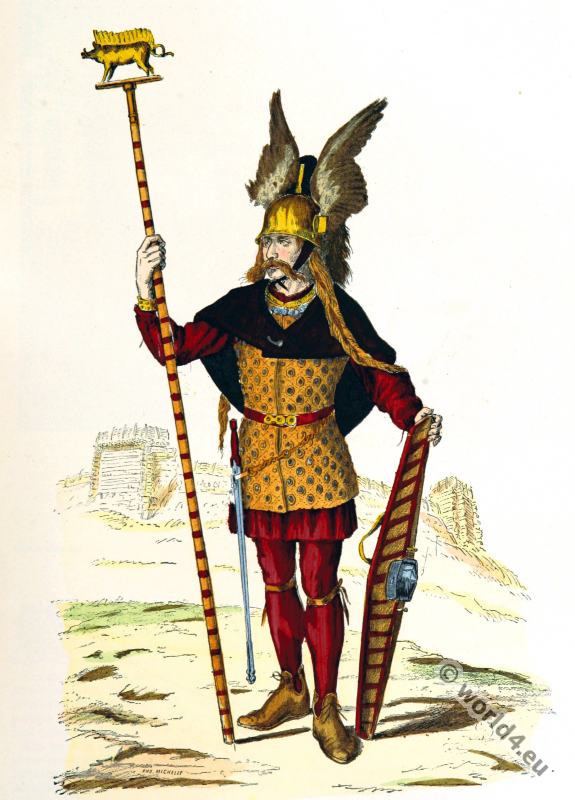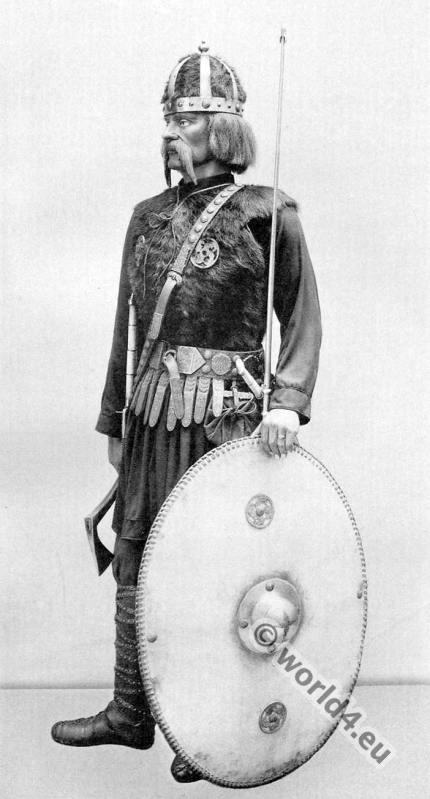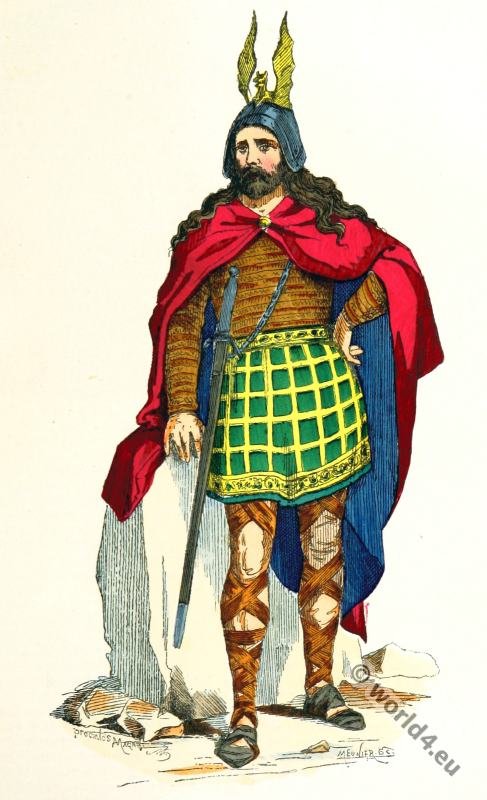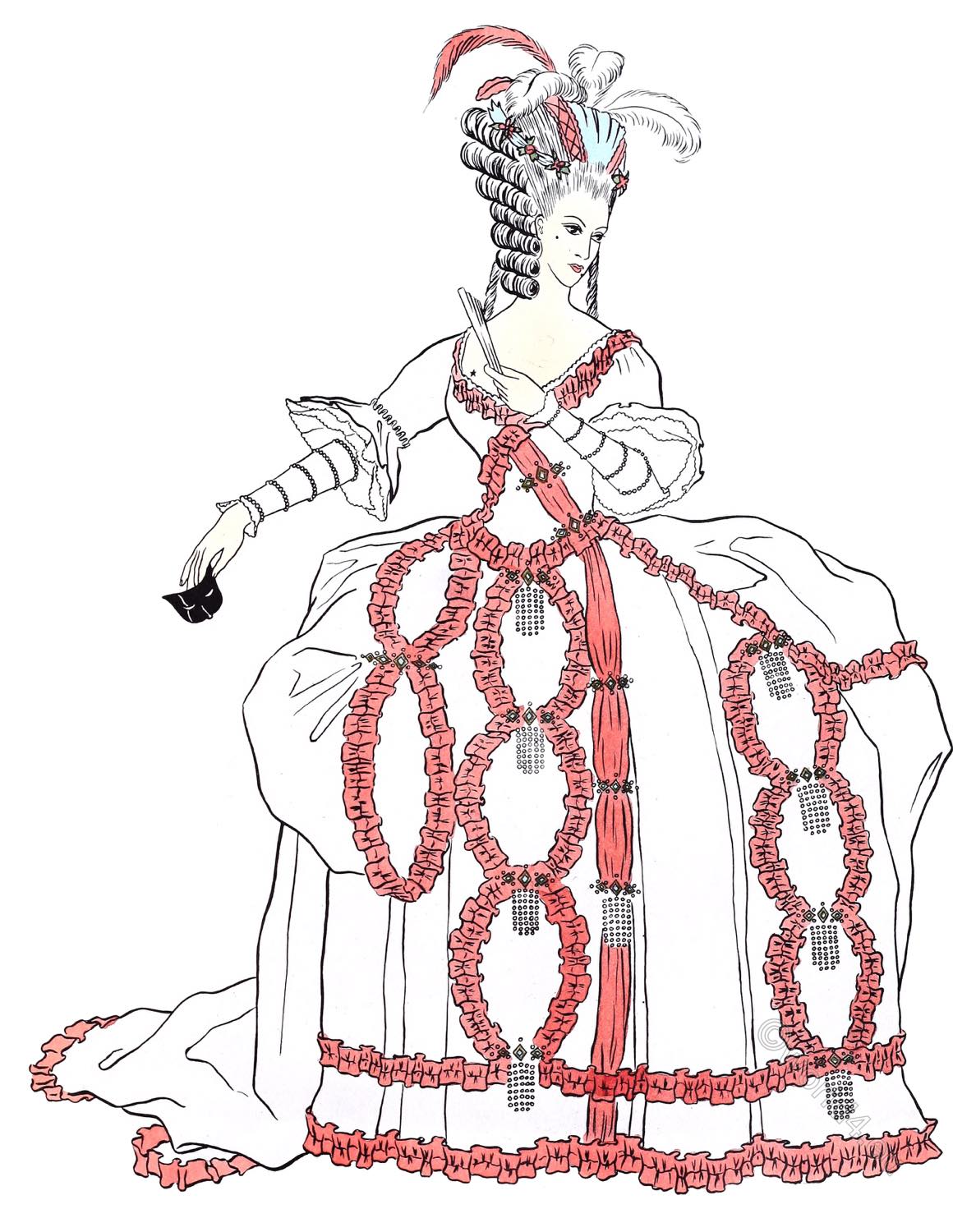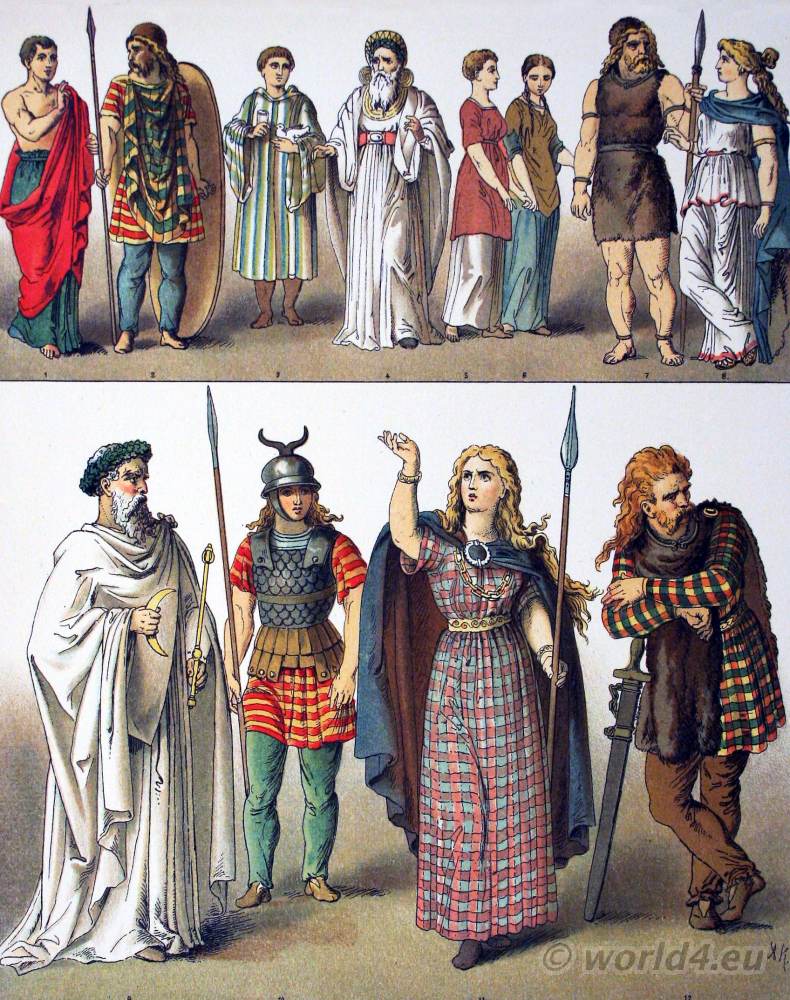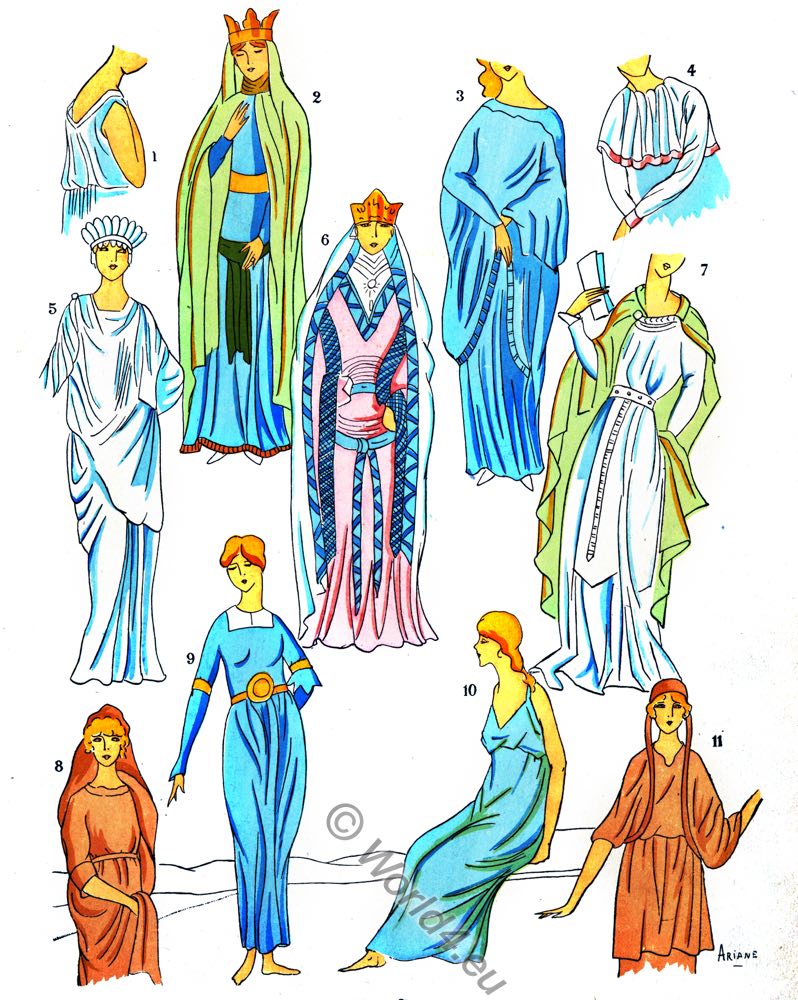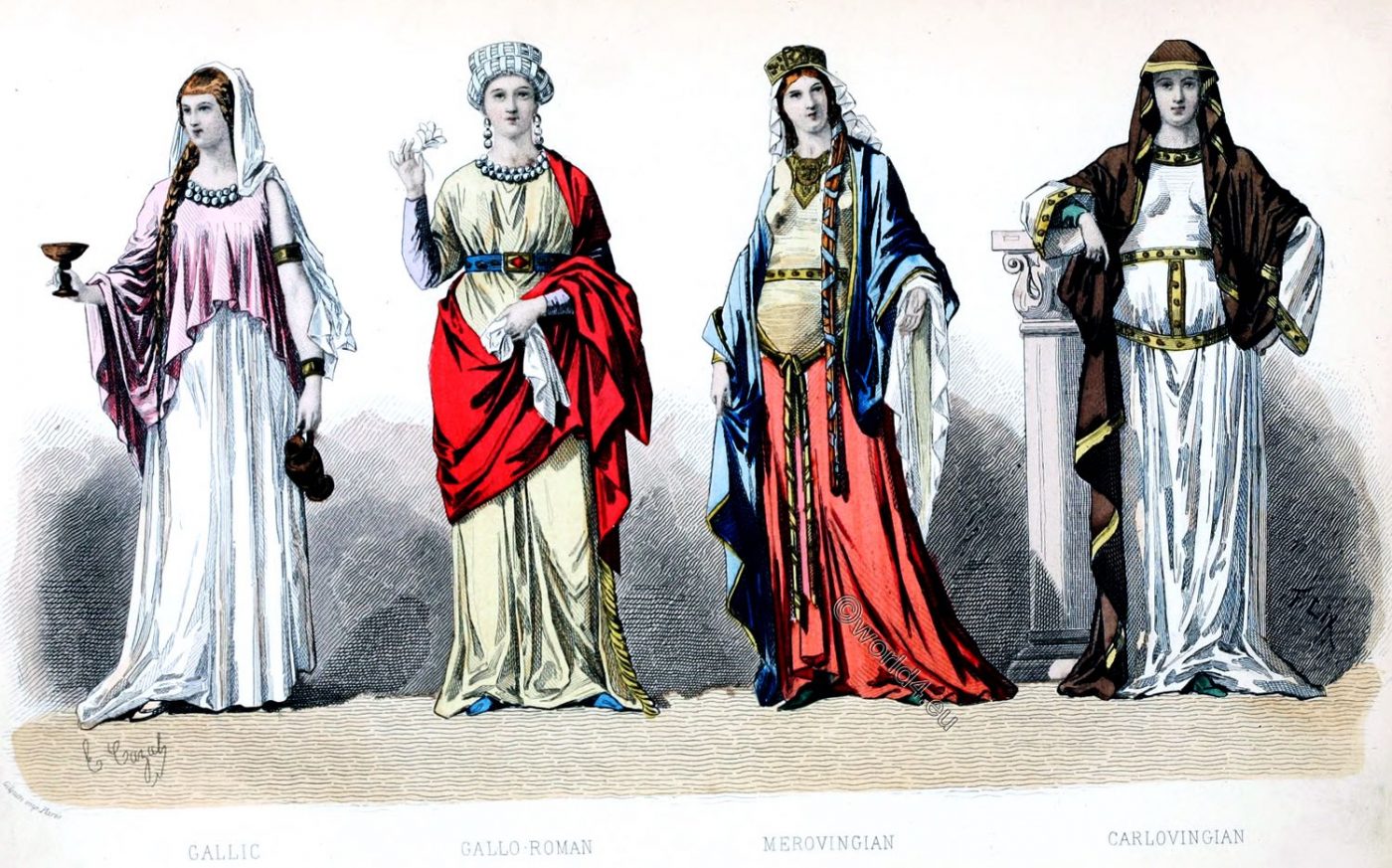
The Gallic and Gallo-Roman costume period.
Content:
Gallic period—Woad, or the pastel — Tunics and boulgètes — “Mavors” and “Palla” — Cleanliness of the Gallic women — The froth of beer or kourou — The women of Marseilles; their marriage-portions — Gallo-Roman period — The Roman garment — The stola — Refinement of elegance — Extravagant luxury of women — Artificial aids — A vestiaire or wardrobe-room of the period — Shoes — Jewels and ornaments — The amber and crystal ball — Influence of the barbarians.
Gallic period—Woad, or the pastel — Tunics and boulgètes.
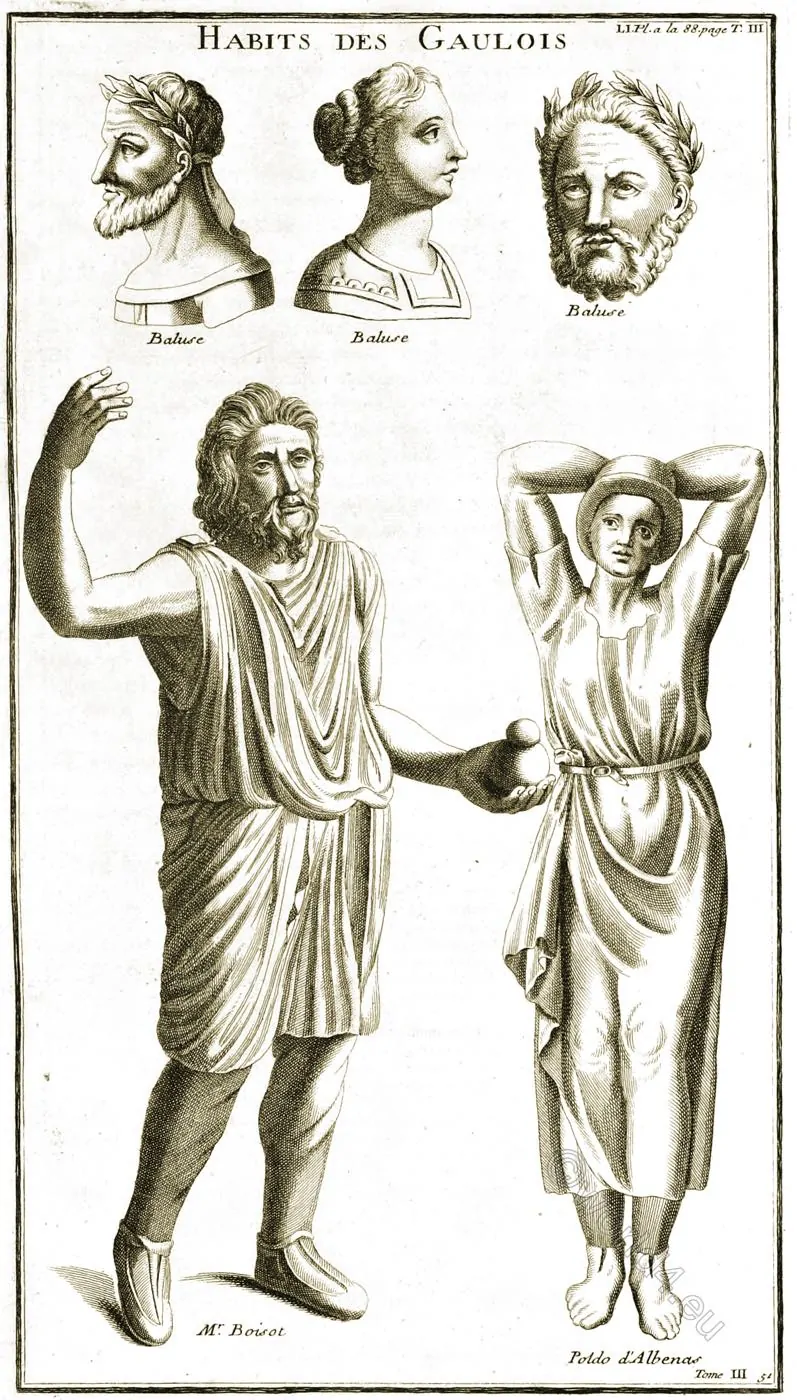
We learn with horror from ancient writers that certain women of Gaul were accustomed to dye their skin with a whitish matter, procured from the leaves of the woad or pastel, a cruciform plant from which is derived a starchy substance, that may be substituted for indigo for certain purposes. Others were tattooed in almost the same manner as the savages of America.
Such were our mothers in primitive Gaul, a country which differed little in extent from modern France.
But time did its work, and a little later, when the inhabitants began to practise industrial arts, the costume of a Gallic woman consisted of a wide plaited tunic and of an apron fastened round the hips. She would sometimes wear as many as four tunics, one over the other, a mantle, part of which veiled her face, and a “mitre” or Phrygian cap. She made use also of pockets or of leathern bags, and of “bouls” or “boulgetes,” made of network, which are still in use in Languedoc, and are called “reticules.”
Rich women remarkable for their beauty and elegance adorned themselves with many-coloured linen mantles, fastening with a clasp on the shoulder; or else they were entirely unclothed to the waist, and draped themselves in a large mantle, which floated over their skirts, and was kept in its place by a clasp or fibula of gold or silver, greatly resembling the modern brooch.
Cleanliness of the Gallic women. The froth of beer or kourou.
A veil covered the head and bosom; when short, it was called a ‘mavors;’ when long, falling for instance to the feet, it bore the name of ‘palla.’ The cleanliness of the Gallic women, which has been praised by historians, added another charm to their unrivalled natural beauty. No Gallic woman, whatever her rank, would have consented or even ventured to wear dirty, untidy, or torn garments; nor did any one of them fail to frequent the baths which were established everywhere, even in the very poorest localities.

The Gallo-Roman woman was admired for her fair complexion, her tall and elegant figure, and her beautiful features; and she neglected nothing that might tend to procure her that homage. Cold bathing, unguents for the face and often for the entire body were to her a delight, a duty, and a necessity. In order to preserve the freshness of her complexion, she bathed her face in the froth of beer or kaurou, dyed her eyebrows with tallow, or with a juice taken from the sea-pike, a fish found on the coast of Gaul. She made frequent use at her toilet of chalk dissolved in vinegar, a mixture injurious to health, but very efficacious as a pommade; she coloured her cheeks with vermilion, put lime on her hair, which she covered with a net, or plaited it into narrow bands, either throwing it back or giving it the curve of a helmet.
Her luxury was not limited to ornaments only, to necklaces, bracelets, rings, or waistbands of metal; she borrowed her charms from Nature too, and, as we have seen, had little reason to complain. Bracelets, which still held their place under the Merovingians, do not seem to have been worn in the Middle Ages.
In the south, on the shores of the Mediterranean, the women were strikingly beautiful. They wore a quantity of jewels, a short garment reaching only to the knees, and a gorgeously bright red apron, such as is worn by the Neapolitans to this day.
The women of Marseilles; their marriage-portions
At Marseilles the civilization of the Greeks had spread among the people. The young girls of the city were always dressed with elegance, and, doubtless lest drink might impair the ivory white of their complexion, custom forbade them to partake of wine; also in order to guard against an excess of luxury, the law required that the highest marriage-portion of a woman should not exceed one hundred golden crowns, nor her finest ornaments five hundred crowns. And that arbitrary law seems to have been strictly enforced.
After the conquest of Gaul by Caesar, Roman civilization and Roman corruption were introduced into our country. It is difficult to resist the attractions of beautiful things, and however great may have been the hatred of their husbands towards the conquerors, the Gallic women, now become Gallo-Romans, were very ready, as may easily be imagined, to follow the example of the ladies from Italy. They declined to be beaten in the art of pleasing, as their warriors had been vanquished on the battle-field.
Gallo-Roman period — The Roman garment – The stola.
The fair Gallo-Roman adopted the fashions of Rome. Extravagance in dress became boundless, and dissimilarity of garments denoted various degrees of wealth. The “stola,” a tunic reaching to the ground, and gathered by a girdle round the hips, while a band adjusted it to the bosom, allowed only the tips of the feet to be seen.
It fell in numerous rich folds, and was as characteristic of the matron as was the “toga” of a citizen of Rome. One lady might be satisfied with a chemise, with the wide drapery of the tunic scolloped at the edge, a short apron and sandals; while another would load herself with tunics, the upper one being sleeveless, sometimes embroidered and sometimes not, confined by a band round the waist, and by a clasp on either shoulder. A sort of mantilla veiled the entire figure.
Some few ladies chose to wear garments which on account of their great breadth were called “palisades” by Horace, the satirical poet of the Augustan age.
Refinement of elegance.
From these the first idea of those vertugadins and crinolines, which we shall frequently be called upon to notice in the course of the present history, appears to have been derived. An elegant town lady would also adorn herself with a mantle that half covered her head, and with the “pallium,” a golden tissue without either clasps or pins, thrown across the left shoulder and round the figure. Another would, like a Gallic woman, wear the Phrygian cap, which allowed her beautiful hair to be seen and admired. This was fastened back with the “vitta,” a ribbon or band which only patricians had the right to use, crossed with narrow bands or confined in a net, and arranged with much skill. The hair was frequently dyed red or yellow; or brown plaits would be concealed under the fair locks taken from some German slave, and lightly sprinkled with gold-dust.
The face of a Gallo-Roman lady was resplendent in beauty, thanks to the refined arts of dress, and her complexion remained incomparably fair in spite of the lapse of years. Beneath the tunic she wore the “strophium,” a sort of corset which defined the figure, and in which she could carry her letters. Ovid observes that to equalize the shoulders, if one were rather higher than the other, it was sufficient to drape lightly the lower of the two. Thus did “postiches” and padding originate.
Extravagant luxury of women.
The Gallo-Roman lady soon began to make use of the “sudarium” or pocket-handkerchief, a piece of stuff, either plain or embroidered, which she held in her hand to wipe the damp from her forehead, or to use as we use our handkerchiefs. We can imagine her leaving her gilded chariot, a sort of palanquin whose shafts were supported by a pair of horses, mules, or oxen. This was a closed carriage lined with skins and strewn with straw, and the noble lady lay within it, softly reposing on a “pulvinar,” or large silken cushion scented with roses. She had adopted the manners, if not the morals of the East. She could appreciate and admire and amass rings of gold, silver ornaments for her dressing-table, for the bath-room, for travelling; mirrors, earrings of incrusted glass, rings, and necklaces. She made use of many different perfumes; scented and hygienic pomatums, essence of lilies, roses, and myrrh, unguents made from the cock and from pure spikenard. She delighted in waistbands and ribbons, in cushions, furs, and felt,—in one word, in all the luxuries that contribute to cleanliness and elegance. She had a decided taste for showy colours.
The wardrobe of a Gallic-Roman lady would consist of tissues of linen, cotton, or silk, taking the place of the modern chemise; of a sort of boneless corset to support the bosom, of a dressing gown, of robes of ceremony, of tunics, half tunics, and violet-coloured mantles, shaped much like a modern pelerine. A Frenchwoman of the present day has not a better assorted wardrobe.
On going out Gallic-Roman ladies donned a short mantle, which covered their shoulders, and a scarf for their head, the light and transparent veil of which their head-dress was composed sparkled with gold and silver spangles, mingled with narrow bands, ribbons, and beads. They left their pointed and cork-soled slippers, turned up at the toes and without heels, at home. Similar shoes may be seen to this day in the Museum at Clermont, in Auvergne.
Shoes — Jewels and ornaments.
Whenever an elegant patrician lady left her home to take a drive or pay visits, she changed her shoes. Sandals took the place of the “lancia,” or house-slippers. She sometimes wore the “cothurnus,” a walking-boot, unrivalled, except by the light shoes called “campodes,” habitually worn by the peasant women.
Shoes were marks of distinction. For instance, those called “peribarides” denoted that the Gallo-Roman lady, their wearer, belonged to one of the highest families.
In Gaul, as in Rome, extravagance in jewels and ornaments defied all the sumptuary laws, although the latter were as plentiful as they were useless. Gallo-Romans would not be denit heir gold and silver ornaments.
Cameos and engraved stones, emeralds, amethysts, sapphires, and the finest pearls give immense value to the necklaces, rings, bracelets, large circular earrings, and even garters, of that remote period. Garters, we beg to point out, were not used to keep up stockings, which were not worn in those times, but served to confine a sort of trouser of fine linen. Some of the Gallo-Roman ladies wore these garters or anklets on the bare leg, as they wore bracelets on the arm.
Parasols, steel mirrors, fans—all these things were known to the Gallo-Roman period. Perfumers were constantly making fresh discoveries, and there were dentists who manufactured marvellous false teeth, so as “to repair the irreparable injuries of Time.” Any defects in the face were remedied by drugs of all kinds. The eyelids were stained in order to give brilliancy to the eyes.
The amber and crystal ball.
At least twenty women were in the service of each patrician lady, and the latter always devoted much time and thought to her dress. These women attired her with exceeding care; they were admirable hair-dressers, and used pomatum profusely. One was the proud bearer of a parasol. A Roman fashion, borrowed from the Egyptians, prescribed that slaves should carry in silver or golden nets the amber and crystal balls used by their mistresses.
With what grace and skill did these noble ladies twist and press the crystal balls in their fingers at a public fete, or at the circus or theatre! They subdued by this means the excessive warmth of their hands, and secured a constant coolness. When the crystal ball became heated, it was succeeded by one of amber, which as it warmed gave forth a most delightful odour.
In like manner the fan offered opportunities for the Gallo- Roman ladies to display all their grace and skill, and the fan has retained its place down to our own time, while it has found an historian in M. Blondel, who has published a very curious monograph on fans among ancient and modern peoples.
The Gauls of both sexes had a patriotic love of their national costume, which they would not discard even when travelling in Asia. Nevertheless, they did not refuse to learn from their Roman conquerors, whose advanced civilization took gradual hold of our ancestors, and ended by metamorphosing them.
Influence of the barbarians.
Did they borrow something from the costumes of the Vandals, Huns, Goths, and Burgundians, from the various barbarians who appeared in succession on the soil of Gaul? We may believe that they did, for the women who accompanied those wild invaders must have left everywhere behind them some trace of their passage. As they sat making their garments in their tents, they must have inspired the Gallo-Roman women with a wish to imitate this or that accessory of the toilet, so soon as the terror caused by the presence of the soldiery had passed away. And though some of these strangers wore only the skins of beasts, others were accustomed to “the purple,” and to tissues from the East; some few combined Greek elegance with Latin wealth, and were covered with valuable ornaments.
The Visigoths mingled with the peoples of Southern Gaul, and the women were sufficiently civilized to be not unpleasing to the vanquished.
At Toulouse, where the Gothic kings had fixed their abode, a large and splendid court, which was destined to exercise an undisputed sway during many centuries, had risen round them. The Burgundians, who had established themselves between the banks of the Lake of Geneva and the confluence of the Moselle and the Rhine, looked upon the Gallo-Romans not as subjects, but as brethren; nor did their laws forbid marriage between themselves and the inhabitants of a conquered country. They evidently followed more or less slowly the progress of civilization in Gaul, and their manners and customs and even their dress influenced and were influenced in their turn by those of the inhabitants of the occupied country.
It may be that no history of the art of Dress will ever be verified by the documents necessary for the accurate reconstruction of the details of female costume from the first invasion of the barbarians until the last, that of the Franks, of which we are now about to note the most striking effects.
Such lapses are to be regretted, but they could not be filled up without venturing on unfounded hypotheses or unsupported fancy. It is better to restrict ourselves to the exact truth than to change the pen of history for that of romance.
By Augustin Challamel.
Related
Discover more from World4 Costume Culture History
Subscribe to get the latest posts sent to your email.


